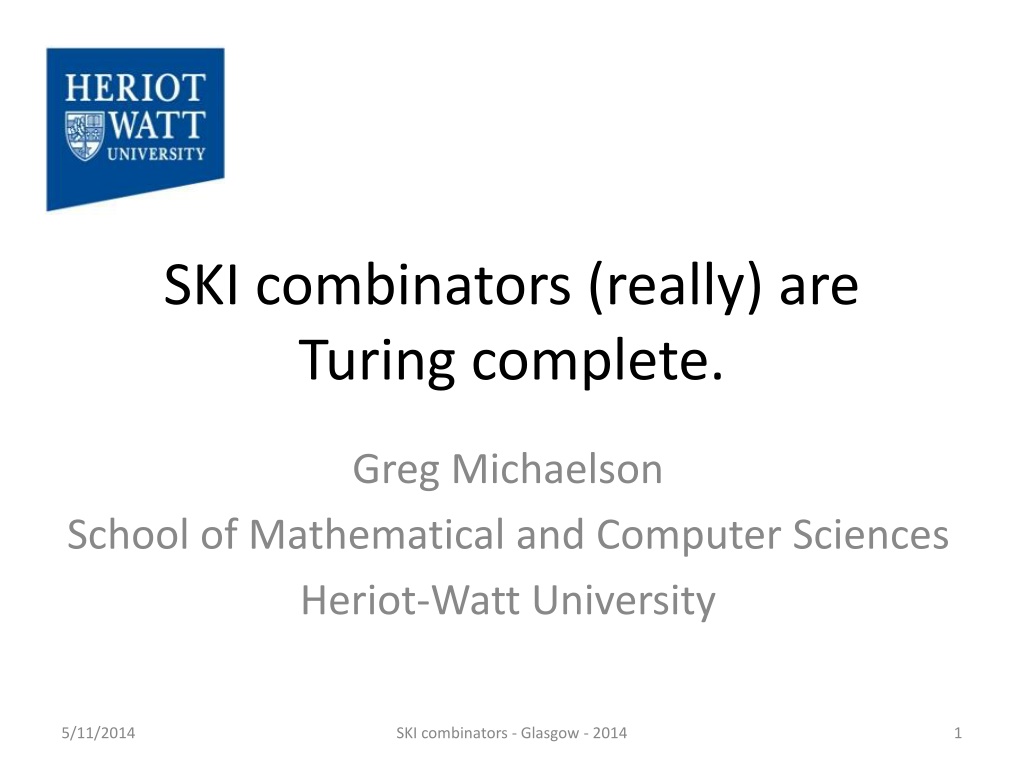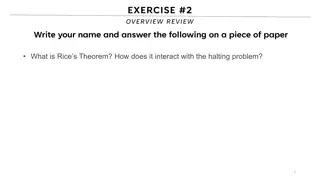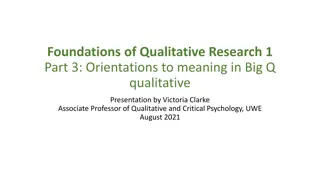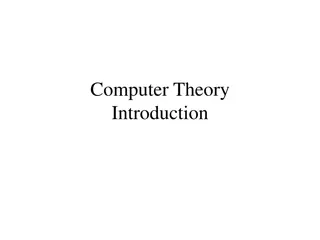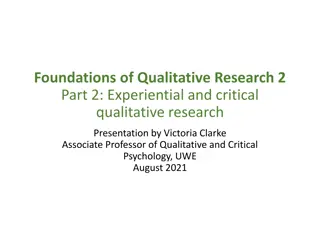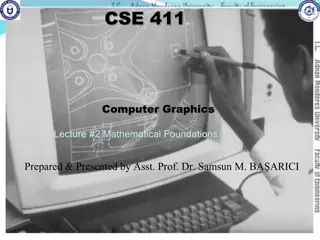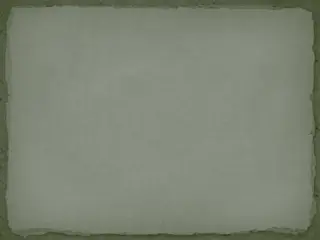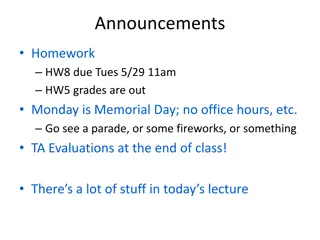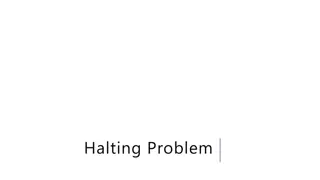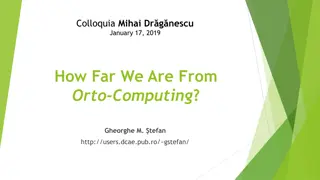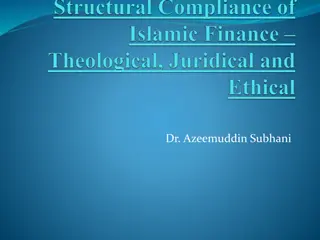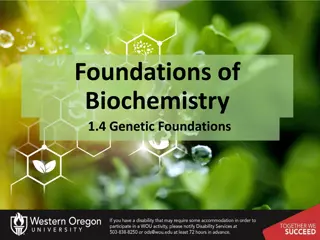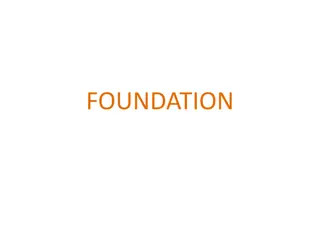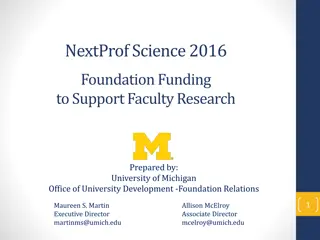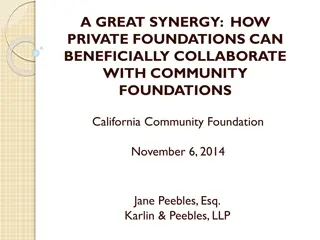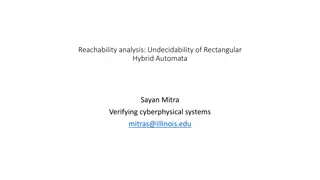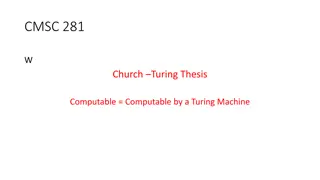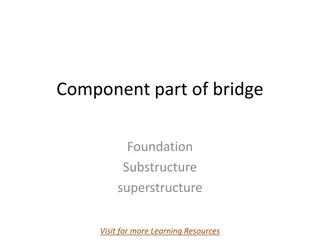Understanding Combinators and Computability: Unveiling the Foundations
Delve into the realm of combinatorial logic and computability through the lens of SKI combinators, exploring their Turing completeness and connection to algorithmic decision-making. Discover the historical significance of Hilbert's program, Godel's incompleteness proofs, the Church-Turing thesis, lambda calculus syntax, and the mechanics of Turing machines in this intriguing exploration of theoretical computer science.
Download Presentation

Please find below an Image/Link to download the presentation.
The content on the website is provided AS IS for your information and personal use only. It may not be sold, licensed, or shared on other websites without obtaining consent from the author. Download presentation by click this link. If you encounter any issues during the download, it is possible that the publisher has removed the file from their server.
E N D
Presentation Transcript
SKI combinators (really) are Turing complete. Greg Michaelson School of Mathematical and Computer Sciences Heriot-Watt University 5/11/2014 SKI combinators - Glasgow - 2014 1
Overview 1. Combinators and computability 2. Combinators and computing 3. A Turing machine for combinators 4. Towards a TM scripting language 5/11/2014 SKI combinators - Glasgow - 2014 2
Combinators and computability Hilbert s programme is there a complete & consistent formalisation of number theoretic predicate calculus? is the entschiedungsproblem decidable? i.e. is there a terminating algorithm to determine whether or not an arbitrary NTPC formula is a theorem? 5/11/2014 SKI combinators - Glasgow - 2014 3
Combinators and computability entschiedungsproblem became an important locus of 1930 s mathematical logic research after Godel s incompleteness proofs two best known approaches lambda calculus Church early1930s Turing machines Turing mid/late1930s 1936 both Turing & Church showed that the entschiedungsproblem is undecidable 5/11/2014 SKI combinators - Glasgow - 2014 4
Combinators and computability what is an algorithm? Turing == computable by machine Church == effectively calculable by normalisation both quickly agreed that their notions were equivalent Church-Turing thesis all characterisations of algorithm are equivalent 5/11/2014 SKI combinators - Glasgow - 2014 5
Combinators and computability lambda calculus syntax: e -> id | id.e | (ee) reduction: id.e1e2 e1[id/e2] i.e. replace id free in e1with e2 5/11/2014 SKI combinators - Glasgow - 2014 6
Combinators and computability Turing machine bounded tape of cells of symbols read/write head over current cell transitions: (state1, symb1) -> (state2, symb2,direction) i.e. in state1 reading symb1, change to state2, write symb2 and move tape in direction 5/11/2014 SKI combinators - Glasgow - 2014 7
Combinators and computability combinators are an older approach Schonfinkel - 1924 Curry - 1927 far closer to lambda calculus then TMs 5/11/2014 SKI combinators - Glasgow - 2014 8
Combinators and computability basic combinators: I x x identity K x y x true/first S x y z x z (y z) e.g. S K I I K I (I I) I 5/11/2014 SKI combinators - Glasgow - 2014 9
Combinators and computability in principle, only S & K needed in practice, additional combinators defined on S/K/I base seductive as: no name/value bindings to maintain simple algorithms to convert to/from lambda calculus 5/11/2014 SKI combinators - Glasgow - 2014 10
Combinators and computing Turner - 1979 devised new bracket abstraction algorithm for converting lambda calculus to combinators used combinators as target for 1976 SASL origins of combinator graph reduction compile programme to AST/graph of composed combinators reduce graph 5/11/2014 SKI combinators - Glasgow - 2014 11
Combinators and computing exploit potential parallelism? S x y z x z (y z) only need to evaluate z once basis of 1980s 5th Generation architectures for functional languages 5/11/2014 SKI combinators - Glasgow - 2014 12
Combinators and computing e.g. UK Alvey Programme SKIM Norman Cambridge sequential - custom hardware 1980 ALICE Darlington Imperial parallel transputer - 1981 COWEB Hankin Imperial WSI - design only 1985 GRIP Peyton Jones UCL/Glasgow parallel - Motorola 68020 - 1987 5/11/2014 SKI combinators - Glasgow - 2014 13
Combinators and computing e.g. PCM-1 - Sale - Tasmania, New Zealand - 1989 e.g. ABC machine - Plasmeijer et al - Nijmegen, Netherlands - 1991 why aren t we all programming commodity graph reduction machines today? 1 lambda expression multiple combinators & 1 combinator multiple machine level instructions S combinator requires dynamic memory management 5/11/2014 SKI combinators - Glasgow - 2014 14
Combinators and computing combinators still at heart of Haskell lambda lifting Johnsson 1985 remove free variables by abstraction super combinator lifting Hughes - 1982 extract maximal free expressions treat as atomic ghc: Haskell super combinators STG machine code C-- C machine code 5/11/2014 SKI combinators - Glasgow - 2014 15
A Turing machine for combinators Turing complete == can compute anything that a TM can compute to show formalism X is Turing complete, define: a) translator from instances of X to provably equivalent instances of some TC formalism compiler or: b) semantics preserving algorithm to reduce instances of X to normal form in some TC formalism interpreter 5/11/2014 SKI combinators - Glasgow - 2014 16
A Turing machine for combinators and: c) translator from instances of some TC formalism to provably equivalent instances of X - compiler or: d) semantics preserving algorithm to reduce instances of some TC formalism to normal form in X - interpreter 5/11/2014 SKI combinators - Glasgow - 2014 17
A Turing machine for combinators Kleene showed that lambda calculus & recursive function theory are equivalent - 1936 Turing- 1937: constructed a TM to reduce lambda expressions implemented? sketched how to convert TMs to recursive functions 5/11/2014 SKI combinators - Glasgow - 2014 18
A Turing machine for combinators for arbitrary language, common to write: compiler to lambda calculus interpreter in lambda calculus in arbitrary language, common to write interpreter for TMs very rare to write interpreting TMs translators to TMs 5/11/2014 SKI combinators - Glasgow - 2014 19
A Turing machine for combinators straightforward to translate: combinators to lambda calculus by definition lambda calculus to combinators bracket abstraction straightforward to write: combinator interpreter in lambda calculus pattern match on AST 5/11/2014 SKI combinators - Glasgow - 2014 20
A Turing machine for combinators lambda calculus is TC so combinators are TC indirect can we directly construct a TM to reduce combinatory expressions? yes, but... 5/11/2014 SKI combinators - Glasgow - 2014 21
A Turing machine for combinators overview , = symbol sequences; ei = combinator expression I e -> e copy e left over I, erasing K e1 e2 -> e1 copy left over e2, erasing K e1 copy e1 over K, erasing e1 5/11/2014 SKI combinators - Glasgow - 2014 22
A Turing machine for combinators S e1 e2 e3 -> e1 e3(e2 e3) copy (e2 e3) right after erasing e2 S e1_e3 (e2 e3) copy right after (e1 e3) S e1_e3 (e2 e3) copy (e2 e3) left over , erasing S e1 _e3(e2 e3) 5/11/2014 SKI combinators - Glasgow - 2014 23
A Turing machine for combinators copy e3(e2 e3) left, erasing Se1 e3(e2 e3) copy e1e3(e2 e3) left over S, erasing e1 e3(e2 e3) 5/11/2014 SKI combinators - Glasgow - 2014 24
A Turing machine for combinators not straightforward... consider syntax: e -> S | K | I | (es) es -> e | e es combinator machines/interpreters process ASTs concrete syntax symbol sequence on tape need to repeatedly parse tape to locate : redexes sub-expressions/arguments 5/11/2014 SKI combinators - Glasgow - 2014 25
A Turing machine for combinators parsing arguments involves bracket matching classic push down automata problem use left of tape as stack Turing invented this technique in 1937 during argument parse may: rewrite argument erase argument 5/11/2014 SKI combinators - Glasgow - 2014 26
A Turing machine for combinators other challenges include remove nested brackets potentially introduced by S find new redex if too few arguments for current combinator 5/11/2014 SKI combinators - Glasgow - 2014 27
A Turing machine for combinators 5/11/2014 SKI combinators - Glasgow - 2014 28
A Turing machine for combinators find redex 5/11/2014 SKI combinators - Glasgow - 2014 29
A Turing machine for combinators find redex remove nested (...) 5/11/2014 SKI combinators - Glasgow - 2014 30
A Turing machine for combinators find redex find 1st argument remove nested (...) 5/11/2014 SKI combinators - Glasgow - 2014 31
A Turing machine for combinators find redex find 1st argument remove nested (...) K: delete 2nd argument 5/11/2014 SKI combinators - Glasgow - 2014 32
A Turing machine for combinators find redex find 1st argument remove nested (...) K: delete 2nd argument S: mark 2nd argument 5/11/2014 SKI combinators - Glasgow - 2014 33
A Turing machine for combinators find redex find 1st argument remove nested (...) K: delete 2nd argument S: mark 2nd argument S: copy 2nd argument to end 5/11/2014 SKI combinators - Glasgow - 2014 34
A Turing machine for combinators find redex find 1st argument remove nested (...) K: delete 2nd argument S: mark 2nd argument S: copy 2nd argument to end S: copy 3rd argument to end 5/11/2014 SKI combinators - Glasgow - 2014 35
A Turing machine for combinators find redex find 1st argument remove nested (...) K: delete 2nd argument S: mark 2nd argument S: copy 2nd argument to end S: copy 3rd argument to end S: copy all after 3rd argument to end 5/11/2014 SKI combinators - Glasgow - 2014 36
A Turing machine for combinators find redex find 1st argument remove nested (...) K: delete 2nd argument S: mark 2nd argument S: copy 2nd argument to end S: copy 3rd argument to end S: copy all after 3rd argument to end move left to close gaps 5/11/2014 SKI combinators - Glasgow - 2014 37
A Turing machine for combinators based on transition system left most, outer most redex reduction 1018 quintuplets 126 states 24 symbols not entirely practical e.g. 253 steps to reduce S K I I 5/11/2014 SKI combinators - Glasgow - 2014 38
A Turing machine for combinators @<@(SKII)> 1,<,2,<,R <@(@SKII)> 2,(,3,{,R <{@S@KII)> 3,S,3,S,R <{S@K@II)> 3,K,3,K,R <{SK@I@I)> 3,I,3,I,R <{SKI@I@)> 3,I,3,I,R <{SKII@)@> 3,),6,},L <{SKI@I@}> 6,I,6,I,L <{SK@I@I}> 6,I,6,I,L <{S@K@II}> 6,K,6,K,L <{@S@KII}> 6,S,6,S,L <@{@SKII}> 6,{,6,{,L @<@{SKII}> 6,<,6,<,L @_@<{SKII}> 6,_,7,_,R _@<@{SKII}> 7,<,10,<,R _<@{@SKII}> 10,{,10,{,R _<{@S@KII}> 10,S,10,S,R _<{S@K@II}> 10,K,10,K,R _<{SK@I@I}> 10,I,10,I,R _<{SKI@I@}> 10,I,10,I,R _<{SKII@}@> 10,},11,},L _<{SKI@I@}> 11,I,11,I,L 5/11/2014 _<{SK@I@I}> 11,I,11,I,L _<{S@K@II}> 11,K,11,K,L _<{@S@KII}> 11,S,11,S,L _<@{@SKII}> 11,{,15,{,R _<{@S@KII}> 15,S,30,Z,R _<{Z@K@II}> 30,K,41,k,L _<{@Z@kII}> 41,Z,100,Z,R _<{Z@k@II}> 100,k,100,k,R _<{Zk@I@I}> 100,I,111,1,R _<{Zk1@I@}> 111,I,115,I,L _<{Zk@1@I}> 115,1,115,1,L _<{Z@k@1I}> 115,k,116,k,R _<{Zk@1@I}> 116,1,121,-,R _<{Zk-@I@}> 121,I,121,I,R _<{Zk-I@}@> 121,},121,},R _<{Zk-I}@>@ 121,>,121,>,R _<{Zk-I}>@_@ 121,_,118,I,L _<{Zk-I}@>@I 118,>,118,>,L _<{Zk-I@}@>I 118,},118,},L _<{Zk-@I@}>I 118,I,118,I,L _<{Zk@-@I}>I 118,-,116,-,R _<{Zk-@I@}>I 116,I,125,i,R SKI combinators - Glasgow - 2014 39
A Turing machine for combinators _<{Zk-i@}@>I 125,},125,},R _<{Zk-i}@>@I 125,>,125,>,R _<{Zk-i}>@I@ 125,I,125,I,R _<{Zk-i}>I@_@ 125,_,141,I,L _<{Zk-i}>@I@I 141,I,141,I,R _<{Zk-i}>I@I@ 141,I,141,I,R _<{Zk-i}>II@_@ 141,_,142,),L _<{Zk-i}>I@I@) 142,I,142,I,L _<{Zk-i}>@I@I) 142,I,142,I,L _<{Zk-i}@>@II) 142,>,142,>,L _<{Zk-i@}@>II) 142,},142,},L _<{Zk-@i@}>II) 142,i,150,i,R _<{Zk-i@}@>II) 150,},156,-,R _<{Zk-i-@>@II) 156,>,156,>,R _<{Zk-i->@I@I) 156,I,156,I,R _<{Zk-i->I@I@) 156,I,156,I,R _<{Zk-i->II@)@ 156,),156,),R _<{Zk-i->II)@_@ 156,_,158,},L _<{Zk-i->II@)@} 158,),158,),L _<{Zk-i->I@I@)} 158,I,158,I,L _<{Zk-i->@I@I)} 158,I,158,I,L _<{Zk-i-@>@II)} 158,>,158,>,L 5/11/2014 _<{Zk-i@-@>II)} 158,-,150,-,R _<{Zk-i-@>@II)} 150,>,157,(,R _<{Zk-i-(@I@I)} 157,I,157,I,R _<{Zk-i-(I@I@)} 157,I,157,I,R _<{Zk-i-(II@)@} 157,),157,),R _<{Zk-i-(II)@}@ 157,},157,},R _<{Zk-i-(II)}@_@ 157,_,160,>,L _<{Zk-i-(II)@}@> 160,},160,},L _<{Zk-i-(II@)@}> 160,),160,),L _<{Zk-i-(I@I@)}> 160,I,160,I,L _<{Zk-i-(@I@I)}> 160,I,160,I,L _<{Zk-i-@(@II)}> 160,(,160,(,L _<{Zk-i@-@(II)}> 160,-,161,-,L _<{Zk-@i@-(II)}> 161,i,163,I,L _<{Zk@-@I-(II)}> 163,-,163,-,L _<{Z@k@-I-(II)}> 163,k,164,K,L _<{@Z@K-I-(II)}> 164,Z,205,-,R _<{-@K@-I-(II)}> 205,K,210,-,L _<{@-@--I-(II)}> 210,-,211,-,L _<@{@---I-(II)}> 211,{,212,{,R _<{@-@--I-(II)}> 212,-,205,K,R _<{K@-@-I-(II)}> 205,-,205,-,R SKI combinators - Glasgow - 2014 40
A Turing machine for combinators _<{K-@-@I-(II)}> 205,-,205,-,R _<{K--@I@-(II)}> 205,I,213,-,L _<{K-@-@--(II)}> 213,-,214,-,L _<{K@-@---(II)}> 214,-,214,-,L _<{@K@----(II)}> 214,K,215,K,R _<{K@-@---(II)}> 215,-,205,I,R _<{KI@-@--(II)}> 205,-,205,-,R _<{KI-@-@-(II)}> 205,-,205,-,R _<{KI--@-@(II)}> 205,-,205,-,R _<{KI---@(@II)}> 205,(,216,-,L _<{KI--@-@-II)}> 216,-,217,-,L _<{KI-@-@--II)}> 217,-,217,-,L _<{KI@-@---II)}> 217,-,217,-,L _<{K@I@----II)}> 217,I,218,I,R _<{KI@-@---II)}> 218,-,205,(,R _<{KI(@-@--II)}> 205,-,205,-,R _<{KI(-@-@-II)}> 205,-,205,-,R _<{KI(--@-@II)}> 205,-,205,-,R _<{KI(---@I@I)}> 205,I,213,-,L _<{KI(--@-@-I)}> 213,-,214,-,L _<{KI(-@-@--I)}> 214,-,214,-,L _<{KI(@-@---I)}> 214,-,214,-,L 5/11/2014 _<{KI@(@----I)}> 214,(,215,(,R _<{KI(@-@---I)}> 215,-,205,I,R _<{KI(I@-@--I)}> 205,-,205,-,R _<{KI(I-@-@-I)}> 205,-,205,-,R _<{KI(I--@-@I)}> 205,-,205,-,R _<{KI(I---@I@)}> 205,I,213,-,L _<{KI(I--@-@-)}> 213,-,214,-,L _<{KI(I-@-@--)}> 214,-,214,-,L _<{KI(I@-@---)}> 214,-,214,-,L _<{KI(@I@----)}> 214,I,215,I,R _<{KI(I@-@---)}> 215,-,205,I,R _<{KI(II@-@--)}> 205,-,205,-,R _<{KI(II-@-@-)}> 205,-,205,-,R _<{KI(II--@-@)}> 205,-,205,-,R _<{KI(II---@)@}> 205,),219,-,L _<{KI(II--@-@-}> 219,-,220,-,L _<{KI(II-@-@--}> 220,-,220,-,L _<{KI(II@-@---}> 220,-,220,-,L _<{KI(I@I@----}> 220,I,221,I,R _<{KI(II@-@---}> 221,-,205,),R _<{KI(II)@-@--}> 205,-,205,-,R _<{KI(II)-@-@-}> 205,-,205,-,R SKI combinators - Glasgow - 2014 41
A Turing machine for combinators _<{KI(II)---@}@> 205,},222,-,L _<{KI(II)--@-@-> 222,-,223,-,L _<{KI(II)-@-@--> 223,-,223,-,L _<{KI(II)@-@---> 223,-,223,-,L _<{KI(II@)@----> 223,),224,),R _<{KI(II)@-@---> 224,-,205,},R _<{KI(II)}@-@--> 205,-,205,-,R _<{KI(II)}-@-@-> 205,-,205,-,R _<{KI(II)}--@-@> 205,-,205,-,R _<{KI(II)}---@>@ 205,>,225,_,L _<{KI(II)}--@-@_ 225,-,226,_,L _<{KI(II)}-@-@__ 226,-,226,_,L _<{KI(II)}@-@___ 226,-,226,_,L _<{KI(II)@}@____ 226,},227,},R _<{KI(II)}@_@___ 227,_,228,>,L _<{KI(II)@}@>___ 228,},228,},L _<{KI(II@)@}>___ 228,),228,),L _<{KI(I@I@)}>___ 228,I,228,I,L _<{KI(@I@I)}>___ 228,I,228,I,L _<{KI@(@II)}>___ 228,(,228,(,L _<{K@I@(II)}>___ 228,I,228,I,L _<{@K@I(II)}>___ 228,K,228,K,L 5/11/2014 _<@{@KI(II)}>___ 228,{,15,{,R _<{@K@I(II)}>___ 15,K,30,C,R _<{C@I@(II)}>___ 30,I,41,i,L _<{@C@i(II)}>___ 41,C,45,C,R _<{C@i@(II)}>___ 45,i,45,i,R _<{Ci@(@II)}>___ 45,(,46,-,R _<{Ci-@I@I)}>___ 46,I,46,I,L _<{Ci@-@II)}>___ 46,-,46,-,L _<{C@i@-II)}>___ 46,i,46,i,L _<{@C@i-II)}>___ 46,C,46,C,L _<@{@Ci-II)}>___ 46,{,46,{,L _@<@{Ci-II)}>___ 46,<,46,<,L @_@<{Ci-II)}>___ 46,_,47,(,R (@<@{Ci-II)}>___ 47,<,47,<,R (<@{@Ci-II)}>___ 47,{,48,{,R (<{@C@i-II)}>___ 48,C,48,C,R (<{C@i@-II)}>___ 48,i,48,i,R (<{Ci@-@II)}>___ 48,-,48,-,R (<{Ci-@I@I)}>___ 48,I,48,-,R (<{Ci--@I@)}>___ 48,I,48,-,R (<{Ci---@)@}>___ 48,),49,-,L (<{Ci--@-@-}>___ 49,-,49,-,L SKI combinators - Glasgow - 2014 42
A Turing machine for combinators (<{Ci-@-@--}>___ 49,-,49,-,L (<{Ci@-@---}>___ 49,-,49,-,L (<{C@i@----}>___ 49,i,49,i,L (<{@C@i----}>___ 49,C,49,C,L (<@{@Ci----}>___ 49,{,49,{,L (@<@{Ci----}>___ 49,<,49,<,L @(@<{Ci----}>___ 49,(,49,(,L @_@(<{Ci----}>___ 49,_,50,_,R _@(@<{Ci----}>___ 50,(,51,_,R __@<@{Ci----}>___ 51,<,52,<,R __<@{@Ci----}>___ 52,{,52,{,R __<{@C@i----}>___ 52,C,53,-,R __<{-@i@----}>___ 53,i,200,i,R __<{-i@-@---}>___ 200,-,201,-,L __<{-@i@----}>___ 201,i,201,I,L __<{@-@I----}>___ 201,-,205,-,R __<{-@I@----}>___ 205,I,213,-,L __<{@-@-----}>___ 213,-,214,-,L __<@{@------}>___ 214,{,215,{,R __<{@-@-----}>___ 215,-,205,I,R __<{I@-@----}>___ 205,-,205,-,R __<{I-@-@---}>___ 205,-,205,-,R 5/11/2014 __<{I--@-@--}>___ 205,-,205,-,R __<{I---@-@-}>___ 205,-,205,-,R __<{I----@-@}>___ 205,-,205,-,R __<{I-----@}@>___ 205,},222,-,L __<{I----@-@->___ 222,-,223,-,L __<{I---@-@-->___ 223,-,223,-,L __<{I--@-@--->___ 223,-,223,-,L __<{I-@-@---->___ 223,-,223,-,L __<{I@-@----->___ 223,-,223,-,L __<{@I@------>___ 223,I,224,I,R __<{I@-@----->___ 224,-,205,},R __<{I}@-@---->___ 205,-,205,-,R __<{I}-@-@--->___ 205,-,205,-,R __<{I}--@-@-->___ 205,-,205,-,R __<{I}---@-@->___ 205,-,205,-,R __<{I}----@-@>___ 205,-,205,-,R __<{I}-----@>@___ 205,>,225,_,L __<{I}----@-@____ 225,-,226,_,L __<{I}---@-@_____ 226,-,226,_,L __<{I}--@-@______ 226,-,226,_,L __<{I}-@-@_______ 226,-,226,_,L __<{I}@-@________ 226,-,226,_,L SKI combinators - Glasgow - 2014 43
A Turing machine for combinators __<{I@}@_________ 226,},227,},R __<{I}@_@________ 227,_,228,>,L __<{I@}@>________ 228,},228,},L __<{@I@}>________ 228,I,228,I,L __<@{@I}>________ 228,{,15,{,R __<{@I@}>________ 15,I,30,Y,R __<{Y@}@>________ 30,},235,},L __<{@Y@}>________ 235,Y,235,I,L __<@{@I}>________ 235,{,236,*,R __<*@I@}>________ 236,I,236,I,R __<*I@}@>________ 236,},236,},R __<*I}@>@________ 236,>,228,>,L __<*I@}@>________ 228,},228,},L __<*@I@}>________ 228,I,228,I,L __<@*@I}>________ 228,*,229,*,R __<*@I@}>________ 229,I,229,I,R __<*I@}@>________ 229,},230,),L __<*@I@)>________ 230,I,230,I,L __<@*@I)>________ 230,*,2,(,R __<(@I@)>________ 2,I,2,I,R __<(I@)@>________ 2,),2,),R __<(I)@>@________ 2,>,250,*,L __<(I@)@*________ 250,),250,),L __<(@I@)*________ 250,I,250,I,L __<@(@I)*________ 250,(,250,(,L __@<@(I)*________ 250,<,251,<,R __<@(@I)*________ 251,(,251,(,R __<(@I@)*________ 251,I,251,I,R __<(I@)@*________ 251,),251,),R __<(I)@*@________ 251,*,251,>,H __<(I)@>@________ 5/11/2014 SKI combinators - Glasgow - 2014 44
Towards a TM scripting language TM quintuplets are a rubbish programming language TM is Harvard architecture can t modify quintuplets during execution tape has linear sequential access 5/11/2014 SKI combinators - Glasgow - 2014 45
Towards a TM scripting language lots of repetition in SKI TM e.g. final quintuplets to close up gaps by moving symbols left very similar for different symbols e.g. code for checking bracket matching in different contexts 5/11/2014 SKI combinators - Glasgow - 2014 46
Towards a TM scripting language often want to: work with delimited sequences compare/update/replace arbitrary sequences count sequence lengths need to remember what s been found and where 5/11/2014 SKI combinators - Glasgow - 2014 47
Towards a TM scripting language three ad-hoc techniques: 1. enter unique state group number of state groups grow with distinct circumstances 2. mark what s found in situ number of marks/states grows with distinct symbols 3. record what s found elsewhere on tape have to shuttle up and down tape to maintain record 5/11/2014 SKI combinators - Glasgow - 2014 48
Towards a TM scripting language abstractions not obvious Chomsky Type 2/context sensitive abstractions? s1 -> s2 introduce notional and registers hard to program in context sensitive style add syntactic sugar scripting language must rewrite in finite number of steps to legal TM 5/11/2014 SKI combinators - Glasgow - 2014 49
Towards a TM scripting language symbol set can get very big could introduce: ? == any (old) symbol ! == same (new) symbol doesn t make allowed symbols explicit order or quintuplets becomes significant i.e. must put specific cases before catch all breaks finite rewrite requirement 5/11/2014 SKI combinators - Glasgow - 2014 50
